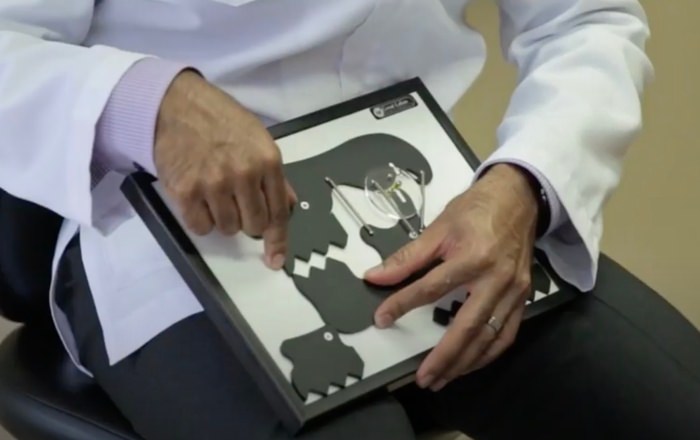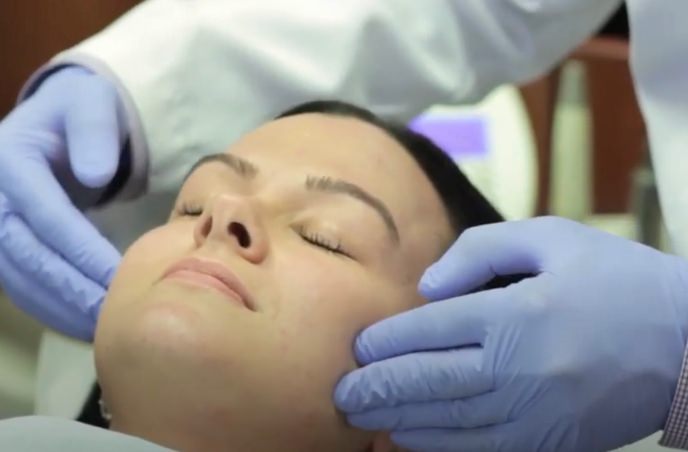Posted on Wednesday, June 3rd, 2020 | 9,908 views
Facial pain around the jawbone joints is unfortunately common but can be managed with the help of a TMJ specialist and some simple exercises. If you have TMJ symptoms you should see your dentist, but you can use the techniques in this article to help alleviate some of the pain and discomfort.
 The jawbone joint, which is clinically known as the temporomandibular joint (TMJ), connects the skull and the jawbone. Every time you speak, yawn, eat, drink or otherwise move your mouth, the temporomandibular joint is involved.
The jawbone joint, which is clinically known as the temporomandibular joint (TMJ), connects the skull and the jawbone. Every time you speak, yawn, eat, drink or otherwise move your mouth, the temporomandibular joint is involved.
Several types of conditions, which are collectively known as temporomandibular disorders (TMD), can cause this type of pain. Notably, the pain may be related to a joint issue, a ligament issue, a muscle issue or a combination of any of them.
Generally, TMJ pain is short-lived and can be managed on your own, but chronic and severe cases may require medical attention and a treatment plan.
There are several self-management steps that you can take to find relief from this bothersome, debilitating pain. The specific methods that work well for you may be dependent on the cause of your pain.
Understanding TMJ Pain and Its Causes
The TMJ has two primary motions. It opens and closes vertically while translating forward and back, and it slides back and forth laterally. Through the combination of these movements, the jaw is able to move functionally to meet all of your needs.
If you are suffering from a temporomandibular disorder, you may feel localized pain around your temples, jaw or ears.
This pain can range from mild to severe. You may also notice that your jaw makes a popping or clicking sound when you open and close it, or it may lock temporarily.
Additional TMD symptoms include ear pain, headaches and sore jaw muscles. The specific symptoms that you experience will vary based on the cause of the pain.
Watch the video below where Dr. Pio Modi provides information on how a dentist can help alleviate and even sure TMD.
General Causes of TMJ Pain
One of the more common and temporary causes of TMJ pain is an injury to the jaw or teeth. This is typically resolved through the natural healing process, but some injuries do require surgery or other significant medical treatments.
TMJ pain may also be caused by bruxism, which is a condition where you clench or grind your teeth without consciously being aware of it. Teeth grinding may occur when you are awake or sleeping.
To treat TMJ pain caused by bruxism, you generally must treat the cause of bruxism. Stress and anxiety have been known to be one of the major factors that cause bruxism.
Sleep apnea may also be a cause but the most common cause of bruxism is related to missing teeth or a poor bite. Even if you do not clench or grind your teeth, a misalignment of the jaw or teeth can cause TMJ pain.
Several other causes could also contribute to or be solely responsible for your pain. For example, excessive gum chewing may cause sore jaw muscles or even cause unnecessary stress on the ligaments.
Arthritis and even poor posture could also be root causes of jaw pain.
How to Manage the TMJ Pain
 If TMJ pain does not go away on its own or if it is severe, you can take anti-inflammatory over-the-counter pain medications such as Advil (Ibuprofen) to help. These will provide temporary relief so that you can get through your day, but they will not address underlying issues.
If TMJ pain does not go away on its own or if it is severe, you can take anti-inflammatory over-the-counter pain medications such as Advil (Ibuprofen) to help. These will provide temporary relief so that you can get through your day, but they will not address underlying issues.
If over-the-counter medications do not provide relief, your doctor may write you a prescription for other medications that can help including tricyclic anti-depressants, and muscle relaxants.
Mouth guards (night-guards) and oral splints may also provide relief for some types of TMD symptoms. For example, a mouth guard can be worn at night by those who grind their teeth while sleeping.
This may deter teeth-grinding and allow the jaw region to heal as long as it is properly designed to work in harmony with how the jaw functions.
Try These Effective TMJ Jaw Exercises
As is the case when you have pain in other joints, you can use TMJ exercises to strengthen muscles and to restore the healthy function of the jaw. They may also stretch tight or tense muscles and help them to relax. Generally, this type of physical therapy will be used in conjunction with heat and ice as needed.
Relaxation exercise
The first jaw exercise involves simple relaxation. Follow these steps:
- Place your tongue on the roof of your mouth.
- Relax the jaw muscles. By doing so, your upper and lower jaw should comfortably come apart. You can easily do this exercise at work or school, while driving or even while waiting in line at a store.
- After practicing the relaxation exercise, open and close your mouth slowly while keeping your tongue in place at the roof of your mouth.
Another exercise is to place your thumb underneath your chin and then use your thumb as resistance while you open the jaw for a few seconds. Then, hold your chin gently using your pointer finger and your thumb while your mouth is closed. Open your mouth using pressure from your finger and thumb as resistance. Then, return your mouth to a closed position and repeat this 10 times.
Chin tuck exercise
A chin tuck is also an effective exercise:
- While standing up, pull your shoulders comfortably back.
- Then, move your head and neck so that you create a double chin.
- After holding this position for a few seconds, return to a relaxed state.
- You can also work on jaw movement by first biting down on a quarter-inch thick object such as popsicle sticks.
- Start by moving your jaw side to side while clenching your teeth on this object.
- Then, move your jaw forward and backward. Do this also for 10 times.
Jaw expansion exercise
For patients who are suffering from limited jaw opening due to sore and tight jaw muscles, there are jaw expansion exercises you can do again using popsicle sticks:
- Using a stack of popsicle sticks that matches how far you can comfortably open your mouth, place the stack of popsicle sticks in your mouth between the back upper and lower teeth.
- Add one popsicle stick to the current stack to expand the jaw.
- Keep the stack of popsicle sticks there for 30-60 seconds 4x/day. 3.
- Continue to add one popsicle stick per week until the stack reaches 40-48mm.
For each of these exercises, you can repeat them several times per session, and you can incorporate several sessions into your daily routine. Your doctor may provide you with more specific suggestions based on your situation. If your pain persists, contact your doctor or dentist to discuss other treatment options.
If you live in Brantford, and you’re feeling pain in your jaw when you chew, talk or drink, visit our TMJ treatments page, where you can find out how we will help alleviate and correct your jaw problems, and where you can make an appointment with one of our dentists.
Read More...
About Dr. Pio Modi
After Dr. Modi graduated from McMaster University with an Honours B.Sc. in chemistry in 1997, he received his Doctorate of Dental Surgery from the University of Toronto in 2001. He began to practice dentistry in Brantford the following year. Throughout his career he's completed hundreds of hours of continuing education programs and has studied with some of the best educators in the industry.
My lower jaw is loose and teeth in lower jaw goes below upper teeth.